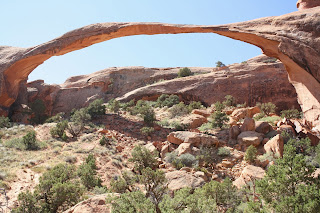Moon Over the Mesa
Moab is a one hundred percent touristy town. Billboards advertise Most Wanted Jeep Adventures, Hot Air Balloon Rides, Red River Adventure Tours, Rim Tours, Redrock Speedway, Skydive Moab, Moab Zipline Above Adventure, Tag-a-Long Tram, as well as the more traditional whitewater river rafting, hiking and biking. And ultra prices fund the ultra challenges. At 8 a.m. we headed back to Arches National Park. |
| Rock fins of Fiery Furnace are visible from the viewpoint. |
Fiery Furnace got its name from the afternoon glow on the rock fins that hide canyons. With a morning sun, the deep red sandstone stood out against a cloudless sky. A special permit is required to hike into the maze. We didn't know.
"Guess we won't be doing that," said Andy, after a short chat with the park ranger on duty at the pullout.
 |
| At 9 a.m. on Thursday, Broken Arch stood silent and alone... far away from civilization. |
 |
| Not even on the map, Tapestry Arch nestles far back on Broken Arch Trail. |
Farther along the loop, we found a side trail: Tapestry Arch, 300 yards. Buried back in where few casual visitors would find it, we discovered Tapestry Arch, a graceful dome of sandstone hidden among rock pillars and fins.
 |
| Appropriately named, Sand Dune Arch was surrounded by dead sand. |
 |
| Piles of boulders under Skyline Arch suggest the origin of this rock formation. |
Farther into the Park is Devil's Garden, a collection of arches that can be seen from foot trails. The main trail head followed the land up and down for nearly half a mile until it reached the split. We took the side trail to Pine Tree Arch first, climbing into the rock fins for a look under the massive stone. Back down the same half-mile side trail, we could see Tunnel Arch high above. "They should have called it Double Tunnel," I suggested, after spotting both openings of the tunnel.
 |
| Protected for safety of visitors, Landscape Arch spans more than 300 feet. |
 |
| Landscape Arch may survive a day or a thousand years. |
I soon turned back from the steep climb along the main trail. "I'll meet you back at Landscape Arch," I called to Andy, as he continued up the sides of the fins to Navajo Arch and Partition Arch. I relaxed on a log under a Utah juniper and people-watched.
A half hour later, Andy reported back. "It's a good thing you didn't follow me," he said. "That descent was really steep. You would have been petrified. And Navajo Arch was nothing to write home about." "That's a good thing too," I told him, "since we have no pictures."
 |
| Partition Arch gives Andy a climbing challenge. |
 |
| From the La Sal Loop Road, Castle Valley looks like a fairy land. |
Leaving Arches National Park, we headed back through the road construction for a circular loop drive through the La Sal Mountains.
Castle Creek Winery on the banks of the Colorado River offered three complimentary tastings per person. We each tried three white wines that were all mild and refreshing sips.
The afternoon shadows cast artistic images across Castle Valley, as we meandered through the back country. Strange rock spires, brilliant red cliffs and steep juniper-covered plateau slopes created picturesque views in every direction.
"These are the mountains we saw in the distance from the Park," said Andy.
Temperatures cooled as we went up in elevation. Following the La Sal Loop Road, we wound our way through pinion pine and Utah juniper forests. From the highest point on the roadway around La Sal Mountain, the world was a fairyland in varying shades of green and yellow. Ground color filled in after a major fire on the back side. All the trees were dead. In another unburned area, aspen trees quivered and quaked in the wind, their tops already tinged yellow and gold. The car recorded an outdoor temperature of 65 degrees, down from 88 degrees in the valley. On the north side in the cove, aspen and pine trees reached stately heights.
 |
| Intricate Double Arch lets in light from all directions. |
After dinner we drove back to Arches National Park to check out the setting sun on the arches. Selecting a section we had previously avoided because of the crowds, we headed to The Windows. That part of the parking lot was still full of cars at sunset, but we found one spot by the trail to Double Arch.
 |
| As the sun sets on Double Arch, light plays in lacey patterns. |
 |
| The moon peeks over the horizon in mid-September, as the Arches landscape darkens. |
No comments:
Post a Comment